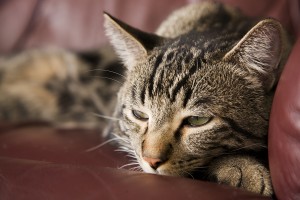Feline diabetes does not differ much from the human version of the same disorder. It has generally the same symptoms, causes, and dangers, making it just as important to treat and diagnose in a cat as it is a human. Untreated diabetes will shorten a cat’s lifespan dramatically and could lead to several complications. The early symptoms are obvious to the knowledgeable cat owner who knows what to watch for, and diagnosis and treatment are not difficult. It only takes a little perseverance and some knowledge to overcome this problem.
Signs and Symptoms
The first thing a cat owner will notice when their feline has developed diabetes is an increase in appetite along with a reduction in weight. This is due to the cat’s body breaking down proteins and fats in order to compensate for the inability to produce or utilize insulin. This leads to high levels of sugar in the bloodstream and urine, which causes increased thirst and urination. The four classic symptoms of cat diabetes are ravenous appetite, weight loss, increased thirst, and increased urination.
 Cats that are at Risk
Cats that are at Risk
Generally, feline diabetes affects cats that are older and obese, and males are more likely to develop diabetes than females, although this disorder does not discriminate and can affect any cat at any time. Feline diabetes has a good chance of resolving itself if the cat is encouraged to lose weight gradually, but immediate veterinary assistance to diagnose and treat this problem is imperative, as untreated diabetes is a life threatening condition.
If Left Untreated
If left untreated, diabetes will dramatically shorten a cat’s lifespan. Increased sugar in the bloodstream causes the blood to become thicker, making it difficult to flow through veins. This puts stress on the heart and other vital organs and results in poor circulation. A fatal complication of feline diabetes is ketoacidosis, marked by loss of appetite, lethargy, weakness, dehydration, and difficulty breathing. An affected feline who has reached this level should see a veterinarian immediately and will probably have to be treated with intravenous fluids. Another complication of diabetes in cats is peripheral neuropathy, which is a weakening of the extremities, especially the hind legs. Affected felines very often walk on their hocks.
Diagnosis
A veterinarian will diagnose diabetes via lab tests, physical examination, and testing for high levels of sugar in the blood and urine.
Treatment
Of the two types of cat diabetes (insulin dependent and noninsulin dependent), approximately 75% of the cases are insulin dependent. Insulin dependent means the cat must receive scheduled injections of insulin. Noninsulin dependent means the cat must take oral medication, usually glipizide, which assists the body with utilizing insulin.
Those cat owners faced with the dilemma of administering insulin shots to a cat on a daily basis should not fear. Insulin needles are very small and typically the cat is not even aware they are receiving a shot. The dosage and scheduling of the medication will be determined by the veterinarian based on a blood sugar profile over the course of a twenty-four hour period. This will indicate to the veterinarian what times of days the cat’s blood sugar spikes or dips and to what degree.
Just as in humans, part of the treatment for diabetes is altering the cat’s diet. A diet that is high in protein is best for diabetic cats. While humans do well on a diet of carbohydrates, cats are carnivores and are not physiologically suited to consuming high levels of carbohydrates, yet many popular cat foods have high concentrations of carbohydrates because it is more cost effective. It’s important for cat owners to read the label. A cat food with less than 10% carbohydrate content is ideal for the diabetic cat. This is more often found in wet cat food as opposed to dry. The best bet is to read the labels and look for less than 10% carbohydrate content, the lower the better.
Precautions
As with humans who are diabetic, cats that are diabetic are also prone to hypoglycemic episodes (bouts of low blood sugar). Treating diabetes successfully is all about keeping blood sugar levels at an optimal level. Blood sugar levels that are too low or too high are both equally dangerous physical states.  Any bout of low blood sugar can be confirmed by testing blood sugar and should be reported to the veterinarian immediately. This is a common occurrence, as insulin dosages do indeed need to be altered from time to time.
Any bout of low blood sugar can be confirmed by testing blood sugar and should be reported to the veterinarian immediately. This is a common occurrence, as insulin dosages do indeed need to be altered from time to time.
With so many factors that affect blood sugar levels, including food intake, hormone levels, and physical exertion, it can seem like a juggling act at times to keep blood sugar levels on an even keel. With the help of a veterinarian and a little observation and loving care from the owner, a feline with diabetes can live a healthy, happy, and active life.

Please contribute to this article discussion and post a comment below...
Powered by Facebook Comments